
According to eCycle website: carbon footprint is a measure that calculates the equivalent emission of carbon in the atmosphere for each person, activity, event, company, organization or government. Many routine activities end up generating atmospheric emissions of greenhouse gases (GHGs).
When we measure the amount of carbon equivalent emitted into the atmosphere we have the carbon footprint of a particular person, company or activity. We believe that not only by living the differences we can co-create a better world, but that we all need to do our part. Besides, the world is our common house.
The carbon footprint is also part of the ecological footprint defined by Rees and Wackernagel, which is a methodology that measures the amount of Planets Earth needed to sustain our lifestyle. The carbon footprint represents more than 50% of the ecological footprint, the fastest growing factor since the 1970s, when the carbon footprint was a small fraction of the ecological footprint.
Knowing our equivalent carbon emissions, directly or indirectly, is very important to reduce them in order to slow down global warming, improve the quality of life of the planet, reduce the ecological footprint and avoid the overshoot, known as the overload of the Earth.
“According to a study published this year in July by Science magazine, planting a few billion trees around the world would be the best way to improve air quality in the future.”
In addition, we can analyze the impacts we cause on the atmosphere and climate change caused by the release of greenhouse gases from each product, process or service we consume.
According to a study published this year in July by Science magazine, planting a few billion trees around the world would be the best way to improve air quality in the future. This is the first research to quantify the trees we could plant on Earth to reduce carbon levels in the atmosphere by up to 25 percent.
A publication of the magazine Galileu points out that “A recent report of the Intergovernmental Panel on Climate Change (IPCC) showed that it would be necessary to plant more than 1 billion hectares to limit to 1.5 ºC the increase in global temperature by 2050.
But how much carbon dioxide do you emit anyway?
Below we have 3 carbon footprint calculators, to know how much each person emits carbon into the atmosphere and how many trees need to be planted, per year, to compensate for all this pollution.
The first calculator is in Portuguese:
This second one is broader and in English:
This third calculator also shows how many planets will be needed if all human beings lived exactly as you do:
The results of the calculations are individual and will be surprising, but we have reached the stage of “we need to talk about it”. So yes, there is no change in behavior without knowledge. That’s why informing ourselves is crucial for awareness and possible reality change.
It is estimated that the Brazilian produces on average 8 tons of CO2 in the atmosphere, per inhabitant (due to what we eat, consume, our travels, car areas, etc).
Because of this, climate change is happening and the planet is warming up. Our “footprints” are getting bigger and bigger. To mitigate this impact and compensate for “our footprints,” the best strategy is to plant trees.
To begin with, an adult tree can absorb approximately 22 kilos of carbon dioxide in one year and produce enough oxygen for two adults to breathe.
The so-called “neutralization”, consisting in compensating the polluting action of the human being with the planting of trees, as much as possible equivalent to the amount of carbon dioxide (CO2) released into the atmosphere – the vegetation absorbs the carbon and pollution is neutralized, is the most indicated way to try to reverse the damage already done.
“To begin with, an adult tree can absorb approximately 22 kilos of carbon dioxide in one year and produce enough oxygen for two adults to breathe.”
Just for you to have an idea, a family that consumes 400 watts of electricity per month, drives a car daily for 20 kilometers and produces 800 grams of garbage per day, needs to plant 12 trees annually to balance its polluting action. A Brazilian lives on average 72 years, and to compensate for the CO2 emitted into the atmosphere during that time, he would have to reforest an area equivalent to 2.5 soccer fields (about 19,500 square meters). And do you know how many trees you owe?
A couple from Rio de Janeiro neutralized all carbon emissions from their wedding ceremony. The calculation included the displacement of 500 guests, some from abroad, the truck that brought the wine from Rio Grande do Sul and electricity, until the honeymoon was counted. The technicians concluded that it would be necessary to plant 36 trees to offset the seven tons of CO2 produced at the event – and so it was done. The seedlings were distributed in a forest in Paraná.
Another example would be a flight from Texas (Lubock) to Curitiba, via Guarulhos, 2.49 tons of CO2 would be emitted.
However, neutralization does not consist only in planting the tree, it is necessary to follow the growth of the plant, especially during the first two years, cut the grass around it and avoid pests. The disadvantage of cultivating a solitary tree is that, when it dies, it also releases carbon – when it is next to similar specimens this effect is neutralized.
Changing habits is essential for reducing the carbon footprint. Choosing products with recyclable or recycled packaging, preferring organic food, using returnable bags, being vegetarian at least once a week (or more than that), composting organic waste, reducing consumerism and leaving the car at home, replacing it with a bicycle or public transportation, are some ideas. One liter of gasoline emits 2.3 kg of carbon equivalent in the atmosphere and the manufacture of five plastic bags emits 1 kg. All these actions contribute to the reduction of the carbon footprint.
Thamy is graduated in International Relations, and lived two years abroad (in Australia), where she was able to connect to different people and herself. After that she started her second graduation in Psychology. At BE she responsible for doing the match between students, organizations and homestays. She also does the company culture alignment and job profile with candidate profile and interests; the recruitment and selection of host families, interview and inspection and selection of the BE team.






